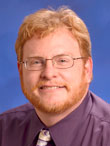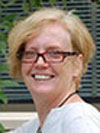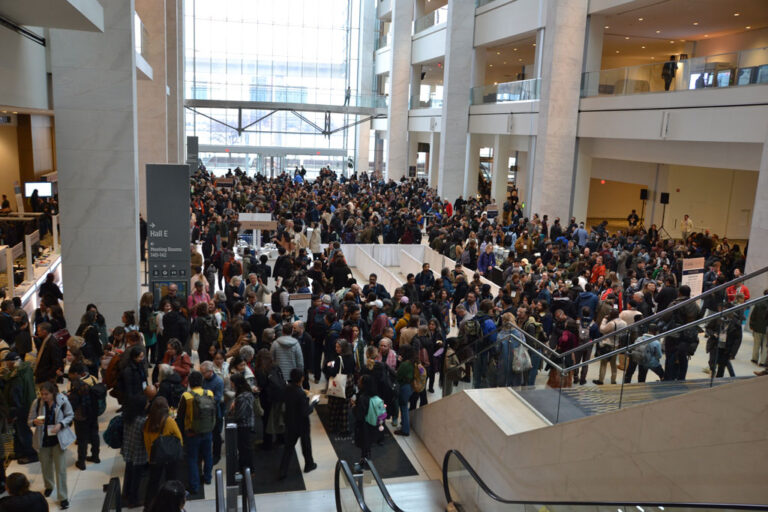Creating Safe Spaces at AAG Meetings for All


Hollywood, The Hill, and the nation’s newsrooms have been exposed as spaces of sexual harassment, misconduct, and even assault. Yet, sexual harassment and discrimination are neither unique nor new to these highly public industries and this misconduct is unfortunately common to most workplaces. Indeed, conservative estimates suggest that 60% of all women have been victims of sexual harassment while a Harvard study found that number to be almost 90 percent for women ages 18 to 25.
The academy can and should be an important tool in studying this issue, collecting the stories of victims, and analyzing the frequency, scale, and impacts of sexual harassment. At the same time, however, higher education is also part of the problem. In a 2014 survey of field scientists, a staggering two-thirds of respondents indicated experiencing sexual harassment at a field site, and one-fifth were victims of sexual assault. Female trainees were much more likely to be targets of harassment and assault than males and “their perpetrators were predominantly senior to them professionally within the research team.” This study also found few respondents aware of mechanisms to report incidents and those who did report indicated being unsatisfied with the result. Reacting to universities’ historically poor record of dealing with sexual- and gender-based harassment and discrimination, “women in academia are beginning to join in the #MeToo campaign, naming predators and speaking out.”
While not discounting advocacy among female scholars, it is not the responsibility of women alone to challenge and transform cultures of inequality and abuse. It requires all members of the academy to adopt diverse and just approaches that are inclusive of gender, race, social class and sexuality. These approaches are critical to the sustained health of the AAG and, importantly, the well-being of our colleagues; they allow us, in the words of past AAG President Victoria Lawson, to develop an ethics of care and responsibility in geography that can enhance relationships, institutions, and professional practices. Now is not the time to be passive or merely reactive about developing and adopting this care ethics. Responsive and proactive institutional and individual interventions are necessary to address this important national moment.
Over the past several months, AAG members have approached both of us to share stories of sexual discrimination and to ask that the Association take a lead against sexual harassment in the academy. In a spirit of joint responsibility and collaboration, this co-authored column seeks to begin what should be a long and committed series of conversations and brainstorming that will allow the AAG, and the larger discipline of geography, to engage with this issue in meaningful and impactful ways.
The purpose of our comments is to highlight the specific importance of ensuring that our annual meetings are “safe spaces” that are free of sexual harassment but also places for raising a larger awareness of discrimination and developing creative advocacy and mentorship initiatives. We encourage members to view the AAG meeting as a place of power-laden social encounters that are consequential to people’s professional and personal development and sense of belonging, safety and security of attendees. The Association has clear expectations about ethical professional conduct at annual meetings, but there is certainly room for further policy and program development.
In an effort to generate discussion about how to bring greater attendee safety and disciplinary understanding of sexual harassment, we review strategies pursued by other professional societies at their meetings while also providing some of our own ideas and suggestions. These suggestions, while requiring action on the part of AAG leadership, rely upon the participation of geographers in regional divisions and individual departments as well as within the national association.
Academic Conferences as Consequential Social Encounters
On the surface, academic conferences appear simply to be about the presentation and discussion of the latest research, teaching innovations, or professional practices. In reality, they are complex social encounters characterized by interpersonal and group exchanges that take place within session meeting rooms and beyond. Indeed, it is this larger cultural milieu of consulting and collaborating with others, participating in fieldtrips and workshops, attending socials and receptions that makes attending a conference enjoyable. However, these encounters—while worthwhile—also carry a vulnerability as junior scholars are put in close contact with senior and powerful scholars while blurring the lines between work and play.
The intellectual, professional, and recreational interactions at academic conferences are part of rather than apart from the inequalities and injustices of daily social life. An online survey of scientific conference attendees reports that sexual and gender-based harassment at meetings includes “catcalling, sexual comments, and other forms of verbal harassment to stalking, groping, and physical assault.” Respondents stated they did not report these incidents for two reasons: they were concerned about the impact to their careers, but secondly, there were no obvious reporting mechanisms at national meetings. Importantly most of this harassment happens in the social spaces of the meeting.
It is important that we are mindful of the contradictory role that annual meetings can play in one’s career. For some of us, the meetings can advance and empower one’s work and self-confidence. For others who face harassment and discrimination, the meeting can be a source of marginalization and isolation, a lasting hit to self-esteem, an obstacle to the freedom to learn and share, and the stunting of career opportunity and security. Attending scholarly meetings and being seen in these social spaces is often critical to the career advancement of emerging scholars who are looking for jobs, pursuing tenure and building their network of colleagues outside of their universities.
AAG Stance on Professional Conduct
To be clear, the AAG has long realized that our annual meeting is a complex operation, socially as well as logistically, and it has been unequivocal in denouncing any form of harassment. According to its statement of Professional Ethics, the Association will not tolerate harassment of any kind, including but not limited to “unwanted sexual advances or demeaning remarks, physical assaults or intentional verbal intimidation and requests for favors (sexual or otherwise) as conditions for recruitment, employment, publication or advancement.”
The AAG also has a Professional Conduct Policy on the AAG meeting web site that briefly but quite clearly expresses the expectation that those attending the conference establish “an atmosphere free of abuse or harassment and characterized by courtesy and respect.” It might make sense to bring greater specificity to issues of sexual harassment, discrimination, and assault within existing AAG conduct policies and ethics statements; nonetheless, the AAG Council and Meridian Place staff takes these matters seriously.
We are happy to report that at the recommendation of the Executive Committee, the AAG Council recently established a Standing Committee on Annual Meeting Attendee Disciplinary Matters. The new committee is charged with investigating and making judgements on violations of the AAG’s Professional Conduct Policy committed by meeting attendees. These violations could conceivably cover a wide range of unprofessional and discriminatory conduct, but would certainly include instances of sexual harassment. Disciplinary action, as determined by the Standing Committee and oversaw by the AAG Council, may include, but need not be limited to, temporary or permanent loss of eligibility to attend future AAG Annual Meetings and/or suspension or temporary or permanent revocation of the membership and eligibility for membership in the Association.
We Need Ideas for Moving Forward
Although professional conduct expectations and mechanisms for investigating misconduct are clearly important, it seems appropriate if not critical to ask if we are doing everything possible to make the national AAG meeting a safe space for all our participants. The question is valid given the nation’s growing awareness of sexual harassment and our own discipline’s white, masculine, and Eurocentric roots and continuing struggles with diversity. Moreover, 41.7 percent of our members are students, a population historically vulnerable to being victims of sexual harassment and assault. It is worth looking to other organizations and within ourselves for ideas on how geography can actively protect colleagues from harassment and discrimination and create opportunities for analytical interventions, advocacy, and awareness building.
Other academic organizations are stepping up their efforts to address harassment at their national meetings. At the December meeting of the American Geophysical Union, two dozen staff members wore badges that said “Safe AGU.” Reinforcing this message were posters throughout the venue that read: “If it is unwanted or unwelcome it is harassment.” Staff members were available to help report an incident but critically to escort a participant through the venue if they believe they are being stalked by another attendee. The Geophysical Union is considering listing sexual harassment as a form of “scientific misconduct” and those found in violation of the Union’s harassment policies will be restricted not just from attending its conferences but also publishing in its journals.
The American Philosophical Association has gone as far as shutting down the open bar at the main reception of its annual meeting and limiting each attendee to two drinks to maintain an atmosphere of professionalism. The Association of Women in Science recommends that every professional society needs to implement anti-harassment policies that cover behavior at meetings and make confidential reporting mechanisms available to participants.
AAG members who have contacted us have suggested a number of good ideas, such as an organization-wide climate survey to see how pervasive the problem of sexual harassment and assault is in the discipline of geography, both in the context of academic conferences and wider workplaces and educational institutions. While the results of such a survey may likely mirror experiences in other associations, it is difficult to move forward and create change if there is not a clear and concrete sense of the scope of this problem and the specific issues that need to addressed. Those contacting us have also asked about the benefits of creating a specific committee or group focused on advocacy. The Geographic Perspectives on Women Specialty Group and the Mentoring Network for Women address to some degree how to navigate harassment and inappropriate behavior in academia. But, there is plenty of room for developing additional spaces at annual meetings and beyond, including at GFDA early career workshops, for sharing of survivors’ stories, creation of networks of support and solidarity, and applying pressure for institutional change. Such a committee could be a highly effective tool for reaching out to and supporting males who have been sexually harassed and assaulted.
In addition to putting safeguards and support in place at annual meetings, a “safe space” approach also emphasizes carrying out wider education and sensitivity training within the field, using not only AAG’s national organizational structure and resources but also its web of regional divisions, departments, programs, and professional workplaces. Geography departments and programs can play an influential role in educating newer scholars and reminding established ones that when they attend an annual meeting, they are operating within this larger ethical and social field of life-changing behaviors and relations. Program leaders and department chairs/heads might consider holding pre-conference orientations that directly address the social encounters that occur at meetings and to enhance community understanding of sexual harassment and discrimination, which include subtle yet harmful micro-aggressions and overt, legally actionable offenses. Offices of equity and diversity on university campuses can be helpful advisors in planning such events. Future AAG healthy department workshops, both at national AAG meetings and during summers, have long held discussions about diversity, but having entire sessions that take on sexual harassment is necessary for preparing department leaders to engage in what can be tough but essential discussions with student, faculty, and staff.
Governing boards of regional divisions of the AAG might consider following the AAG Council’s lead and establish its own committee to respond to professional conduct matters that might arise at their fall meetings. Divisions should also consider sending a strong statement about zero tolerance for harassment and discrimination by composing their own professional ethics policy for their members and regional meeting attendees as well as create formal spaces at these conferences for anti-harassment advocacy, mentoring, and program idea development that could feed and enrich the national organization. At the very least, regional divisions should prominently post the AAG’s professional ethics and conduct statements on their main and meeting-related websites and create active moments to remind attendees of their professional conduct responsibilities, perhaps at the opening session of the meeting, receptions and banquets, or the beginning of World Geography Bowl competitions.
Presidential columns customarily end with a call for readers to share their perspectives, experiences, and ideas. Because we have touched only the surface of what is deep and complex issue, it is especially imperative that members engage in conversations with us, the larger AAG Council as well as with others in their departments and workplaces about sexual harassment and how geographers can take a lead against this injustice. As always, please share your thoughts on Twitter #PresidentAAG.
DOI: 10.14433/2017.0021
— Derek Alderman, AAG President
University of Tennessee
Twitter: @MLKStreet
Email: dalderma [at] utk [dot] edu
— Lorraine Dowler, AAG National Councilor
Pennsylvania State University
Email: lxd17 [at] psu [dot] edu

